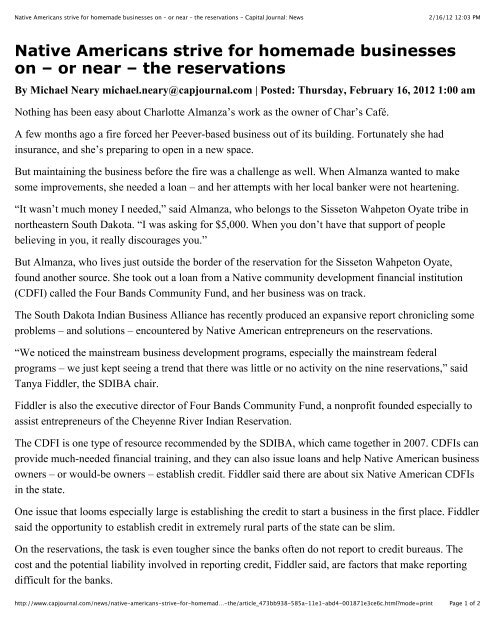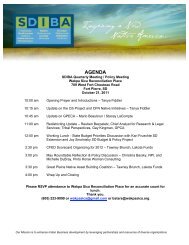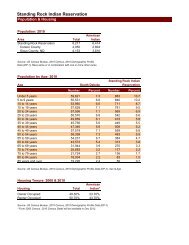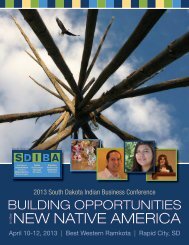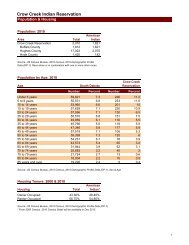Read the article. - South Dakota Indian Business Alliance
Read the article. - South Dakota Indian Business Alliance
Read the article. - South Dakota Indian Business Alliance
Create successful ePaper yourself
Turn your PDF publications into a flip-book with our unique Google optimized e-Paper software.
Native Americans strive for homemade businesses on – or near – <strong>the</strong> reservations - Capital Journal: News2/16/12 12:03 PMNative Americans strive for homemade businesseson – or near – <strong>the</strong> reservationsBy Michael Neary michael.neary@capjournal.com | Posted: Thursday, February 16, 2012 1:00 amNothing has been easy about Charlotte Almanza’s work as <strong>the</strong> owner of Char’s Café.A few months ago a fire forced her Peever-based business out of its building. Fortunately she hadinsurance, and she’s preparing to open in a new space.But maintaining <strong>the</strong> business before <strong>the</strong> fire was a challenge as well. When Almanza wanted to makesome improvements, she needed a loan – and her attempts with her local banker were not heartening.“It wasn’t much money I needed,” said Almanza, who belongs to <strong>the</strong> Sisseton Wahpeton Oyate tribe innor<strong>the</strong>astern <strong>South</strong> <strong>Dakota</strong>. “I was asking for $5,000. When you don’t have that support of peoplebelieving in you, it really discourages you.”But Almanza, who lives just outside <strong>the</strong> border of <strong>the</strong> reservation for <strong>the</strong> Sisseton Wahpeton Oyate,found ano<strong>the</strong>r source. She took out a loan from a Native community development financial institution(CDFI) called <strong>the</strong> Four Bands Community Fund, and her business was on track.The <strong>South</strong> <strong>Dakota</strong> <strong>Indian</strong> <strong>Business</strong> <strong>Alliance</strong> has recently produced an expansive report chronicling someproblems – and solutions – encountered by Native American entrepreneurs on <strong>the</strong> reservations.“We noticed <strong>the</strong> mainstream business development programs, especially <strong>the</strong> mainstream federalprograms – we just kept seeing a trend that <strong>the</strong>re was little or no activity on <strong>the</strong> nine reservations,” saidTanya Fiddler, <strong>the</strong> SDIBA chair.Fiddler is also <strong>the</strong> executive director of Four Bands Community Fund, a nonprofit founded especially toassist entrepreneurs of <strong>the</strong> Cheyenne River <strong>Indian</strong> Reservation.The CDFI is one type of resource recommended by <strong>the</strong> SDIBA, which came toge<strong>the</strong>r in 2007. CDFIs canprovide much-needed financial training, and <strong>the</strong>y can also issue loans and help Native American businessowners – or would-be owners – establish credit. Fiddler said <strong>the</strong>re are about six Native American CDFIsin <strong>the</strong> state.One issue that looms especially large is establishing <strong>the</strong> credit to start a business in <strong>the</strong> first place. Fiddlersaid <strong>the</strong> opportunity to establish credit in extremely rural parts of <strong>the</strong> state can be slim.On <strong>the</strong> reservations, <strong>the</strong> task is even tougher since <strong>the</strong> banks often do not report to credit bureaus. Thecost and <strong>the</strong> potential liability involved in reporting credit, Fiddler said, are factors that make reportingdifficult for <strong>the</strong> banks.http://www.capjournal.com/news/native-americans-strive-for-homemad…-<strong>the</strong>/<strong>article</strong>_473bb938-585a-11e1-abd4-001871e3ce6c.html?mode=printPage 1 of 2
Native Americans strive for homemade businesses on – or near – <strong>the</strong> reservations - Capital Journal: News2/16/12 12:03 PMThe SDIBA’s report notes o<strong>the</strong>r obstacles Native Americans can face when <strong>the</strong>y try to obtain loans. Oneis <strong>the</strong> trust status of land on <strong>the</strong> reservations, which prevents it from being used as collateral when takingout loans. Because reservation land is held in trust status by <strong>the</strong> federal government, <strong>the</strong> land cannot berepossessed by banks offering loans. That means Native Americans living on reservations lack a sourceof collateral available to o<strong>the</strong>rs who might be seeking loans to start new businesses.Fiddler said members of <strong>the</strong> SDIBA noticed, in recent years, a dearth of native-owned businesses onreservations. She said 1 percent of <strong>the</strong> businesses on <strong>the</strong> Cheyenne River Sioux Reservation were ownedby Native Americans in 2001. It’s a reservation, she said, with a population that is 80 percent NativeAmerican.Since that time, though, Fiddler said 100 native-owned businesses have emerged. Fiddler noted trainingand technical assistance, access to capital and increased credit-worthiness as factors in helping <strong>the</strong> newbusinesses to develop.The inability to establish credit, Fiddler said, can affect everyday purchases as well as businessdevelopment.“<strong>Indian</strong> people are poor for some really good reasons,” she said. “Not having access to affordableproducts is one of <strong>the</strong>m.”Scarcity of jobs is ano<strong>the</strong>r. And for many Native Americans who live on or near reservations across <strong>the</strong>state, <strong>the</strong> best path to a good job is not <strong>the</strong> road to <strong>the</strong> nearest large retailer. It’s creating a local business –or working for one that’s recently surfaced.“This is a path out of poverty,” Fiddler said.For Almanza, that path is strewn with home-cooked food. She’s hoping to reopen Char’s Café in April,and she’s especially looking forward to rekindling <strong>the</strong> café’s legendary “pie days.”“Everything is homemade,” she said, “and that’s what makes it good.”http://www.capjournal.com/news/native-americans-strive-for-homemad…-<strong>the</strong>/<strong>article</strong>_473bb938-585a-11e1-abd4-001871e3ce6c.html?mode=printPage 2 of 2


